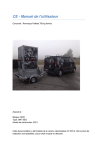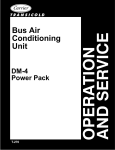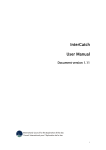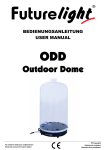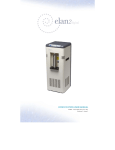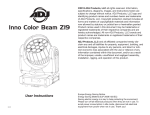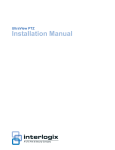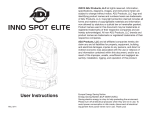Download User Manual pallettrailer 750kg braked 1
Transcript
CE - User Manual Concerns: pallettrailer 750kg braked Associated with: Brand: MCD Type: SW7.5EG Year built: 2013 This documentation has been translated from the Dutch version (01-2014). Translation errors are reserved, no rights can be derived. 2 Version date 01-2014 (translation from Dutch version) © copyright Metaal Centrum Dunning Table of contents Table of contents .................................................................................................................................. 3 Introduction ............................................................................................................................................ 6 Identification .......................................................................................................................................... 7 Warranty and Liability........................................................................................................................... 7 Warranty ............................................................................................................................................. 7 Liability................................................................................................................................................ 8 1. General specifications ..................................................................................................................... 9 1.1 Technical specifications : .......................................................................................................... 9 1.1.1 Dimensions .......................................................................................................................... 9 1.1.2 Weights................................................................................................................................. 9 1.1.3 Tire ........................................................................................................................................ 9 1.1.4 Internia brake....................................................................................................................... 9 1.1.5 Hydraulics installation ........................................................................................................ 9 2. General description ........................................................................................................................ 10 2.1 Intended use machine ............................................................................................................. 10 2.2 Not permitted use ..................................................................................................................... 10 3. Safety ............................................................................................................................................... 10 3.1 Introduction ............................................................................................................................... 10 3.2 Safetyrules ................................................................................................................................ 10 3.3 Users .......................................................................................................................................... 11 3.3.1 Servicepersonel ................................................................................................................ 11 3.4 Workingspace ........................................................................................................................... 11 3.5 Warnings affixed to the trailer ................................................................................................ 11 3.6 Substances dangerous to humans and environment ......................................................... 11 3 Version date 01-2014 (translation from Dutch version) © copyright Metaal Centrum Dunning 3.6.1 General ............................................................................................................................... 11 3.6.2 Storage ............................................................................................................................... 11 3.6.3 Protection of the environment ......................................................................................... 12 3.6.4 Dispose of the trailer ........................................................................................................ 12 3.7 Check before use ..................................................................................................................... 12 3.7.2 Coupling ............................................................................................................................. 12 3.7.3 Lighting ............................................................................................................................... 13 3.7.4 Shock reduction ................................................................................................................ 13 3.7.5 Hydraulics installation ...................................................................................................... 13 3.7.6 Chassis ............................................................................................................................... 13 3.8 Use regulations......................................................................................................................... 14 3.8.1 Connect and disconnect .................................................................................................. 14 3.8.2 Open loading area ............................................................................................................ 15 3.8.3 Lift........................................................................................................................................ 16 3.8.4 The load of the pallettrailer .............................................................................................. 17 3.8.4 Before driving off / Driving position ................................................................................ 19 4. Periodic maintenance .................................................................................................................... 20 4.1 Tires ....................................................................................................................................... 20 4.2 Coupling / Internia brake ..................................................................................................... 20 4.3 Lighting .................................................................................................................................. 21 4.4 Hydraulics installation .......................................................................................................... 21 4.5 Chassis .................................................................................................................................. 22 4.6 Clean ...................................................................................................................................... 22 5. Other maintenance......................................................................................................................... 22 5.1 Repair en maintenance ........................................................................................................... 22 4 Version date 01-2014 (translation from Dutch version) © copyright Metaal Centrum Dunning 5.1.1 Care instructions ............................................................................................................... 22 5.1.2 Repairs / Replacement of parts ...................................................................................... 23 Annexes: .............................................................................................................................................. 24 Annex 1: Additional technical information associated with manual ........................................ 24 Annex 2: Indications on the pallet trailer ..................................................................................... 25 Annex 3: Warnings displayed on the trailer ................................................................................ 26 5 Version date 01-2014 (translation from Dutch version) © copyright Metaal Centrum Dunning Introduction This user documentation describes how to work with and periodic maintenance of the pallet 750kg braked trailer . Operations to be carried out by personnel of manufacturers are not included in this documentation . Note : This documentation is part of the pallet trailer! Keep this documentation carefully. It contains information, which also comes in handy later or necessary for example for repair and maintenance. It is recommended to keep a copy at the pallettrailer and in the archives of your technical department. Manufacturer can possibly make you an extra copy . Upon transfer of the pallettrailer the documentation should be supplied. In addition to provisions in this document are also applicable legal rules for the use of pallettrailers, such as vehicle registration, license plate, speed limits etc.. These legal requirements may vary from country to country and may be modified in the course of time . Make sure you are informed! Both user, operator and service personnel must be aware of what is described in this manual and must follow the guidelines as described. 6 Version date 01-2014 (translation from Dutch version) © copyright Metaal Centrum Dunning Identification This document was originally written in Dutch by: Metaal Centrum DUNNING, located at Bremenweg 6 Groningen. Registered at the Chamber of Commerce Northern Netherlands under number 54090504. Hereinafter referred to as manufacturer. Warranty and Liability Warranty Unless otherwise agreed in writing by the warranty set out below. • • • • • • • • • • • • The manufacturer shall provide warranty on chassis parts to the first user to 12 months after delivery , unless otherwise required by law. Defects in support wheel are outside the warranty assessment. Defects in the cylinder are outside the warranty assessment. Los of separate parts are outside the warranty assessment. Defects must be reported before the expiration of the warranty from the manufacturer The warranty applies to defects: • occur during normal use of the pallettrailer; • caused by faulty construction or materials; • caused by poor workmanship by the manufacturer. The warranty does not cover defects caused by: • normal wear and tear; • Improper or inappropriate use; • use of consumables other than prescribed. When faults occur under warranty, the manufacturer shall : • repair the defects; • replace the parts. The manufacturer is the owner of the replaced parts; • choose another alternative solution, if recovery is not reasonably possible. The owner must give the manufacturer the opportunity to correct any deficiencies. For in/adjoining parts of the third-party vendor warranty terms apply. The warranty period may vary from what is shown above. The manufacturer reserves the right to change the pallettrailer without notice When claiming warranty, the user must follow this user manual and has to demonstrate that the rules are followed as described. 7 Version date 01-2014 (translation from Dutch version) © copyright Metaal Centrum Dunning Liability The manufacturer is not liable for unsafe situations, accidents or damages that result from ignoring warnings or instructions as shown on the pallettrailer or this documentation, for example: • • incorrect or improper use or maintenance; the use for other purposes or under conditions other than those specified in this documentation ; • the use of parts other than specified ; • repairs without the permission of the manufacturer; • changes to the pallet trailer. These include: • changes in the control ; • welding, mechanical processing , etc.; • extensions to the pallettrailer or control. • changes in the assembly of the trailer • changes in the original assembly of the pallettrailer The manufacturer is not liable: • • if the customer all its obligations to the manufacturer (financial or otherwise) has not been met; consequential damage caused by faults or defects in the pallettrailer (for example damage to (handle) products, business interruption, delays, etc.) 8 Version date 01-2014 (translation from Dutch version) © copyright Metaal Centrum Dunning 1. General specifications Brand: MCD Type: SW750EG Year build: 2013 1.1 Technical specifications : 1.1.1 Dimensions Dimensions pallettrailer: 295 x 195cm Dimensions loadingspace: 130 x 125cm 1.1.2 Weights Maximum weight: 750kg Weight pallettrailer: 360kg 1.1.3 Tire Tiresize: 155/70 R12 Tire brand: GT Maxmiller Carrying capacity: 900kg (per tire) Bandendruk:6.5 bar 1.1.4 Internia brake Brand/type: KNOTT KF13C Maximum weight: 1300kg 1.1.5 Hydraulics installation Maximum load cylinder: 2500kg / 300bar Maximum pressure slang: 180bar Dispensing pump: 25cc (per stroke) Capacity oil reservoir: 2liters 9 Version date 01-2014 (translation from Dutch version) © copyright Metaal Centrum Dunning 2. General description The pallettrailer is intended for the transport of goods and must be towed by a towing vehicle. The pallettrailer which these instructions relate suitable for transporting a total weight of up to 750kg. The pallettrailer is equipped with a lifting function with which goods can be lifted from the ground and then can be transported. 2.1 Intended use machine The pallettrailer has to be towed by a towing vehicle with an approved towbar concerning the applicable standards. The trailer includes a pallet lift function, this means that the cargo, can be moved upwards and downwards with the help of the installed hydraulic system, and the devices attached thereto. The pallettrailer should be used to uplift or lowering goods within the capabilities of the pallettrailer and transport of goods within the rules of the road traffic. 2.2 Not permitted use Attention is drawn to the following applications for which the pallet trailer is not suitable: • The transport of persons or livestock onto the pallet trailer. • Use as a lifting device for both people and livestock. 3. Safety 3.1 Introduction This pallet trailer is designed and constructed so that they can be used safely. Maintain and this applies to the application, the conditions and requirements as described in this documentation. Reading the documentation and follow the instructions are so essential for anyone who´s working with or on this pallettrailer. If used, it is the responsibility of the owner / employer that these instructions are known and also used by the staff. There may be additional security measures prescribed by the company or the country where the pallet trailer is in use. This concerns in particular the working conditions. This documentation does not describe additional security measures. Fulfilled however, the necessary information about the pallettrailer data . Check with your government or security officer. Activities that are described in Chapter 4, may only be carried out by appropriately qualified personnel. 3.2 Safetyrules • • • • Ensure that unauthorized persons, such as children, may not operate the pallettrailer if there is no supervision. If there is no supervision the lifting handle must be removed Only people who read the operating instructions and understood them, may operate the pallettrailer . The lifting device should only be used if the pallettrailer is stationary, with the handbrake on, and is disconnected. Do not climb on the pallet trailer used when it´s in use. 10 Version date 01-2014 (translation from Dutch version) © copyright Metaal Centrum Dunning • • • • • • • • • Make sure there are no people in the loadingarea when loading. Safety devices must not be removed or disabled. Keep the work area clean and free of obstructions . Provide adequate lighting conditions. Beware! of crushing between the chassis and the lifting device . Exceeding the maximum load is not allowed. (see type / construction plate) Exceeding the maximum permissible ball pressure is not allowed. (see type / construction plate) Exceeding the maximum load of the tie rails is not allowed. When using the pallettrailer, the operator must be equipped with safety shoes and work gloves . 3.3 Users The pallettrailer can be operated by any adult person who´s aware of and following the safety and operating instructions described this documentation. Special training is not required. For driving the pallettrailer is obviously a relevant driving license required. 3.3.1 Servicepersonel A special knowledge, experience and/or training is required. Fore moving part: knowledge and experience in the field of maintenance of motor vehicles is recuired. The hydraulic part: knowledge and experience in the field of maintenance of hydraulic systems is required. 3.4 Workingspace In order to operate the pallet trailer 150 cm should be free around the pallettrailer. 3.5 Warnings affixed to the trailer The warnings affixed to the pallet trailer shall be clearly legible. If necessary renew the warnings. The text of the warnings made are set out in Annex 3. The relevant risks are also detailed in the same Annex. 3.6 Substances dangerous to humans and environment 3.6.1 General The following substances involved in the operation of the pallettrailer require special attention: • • Hydraulic oil Tire 3.6.2 Storage Save hazardous substances always in a place that is not accessible to unauthorized persons. There may be applicable for the storage of substances legal requirements. Refer to the relevant authority for the regulations and required permits. 11 Version date 01-2014 (translation from Dutch version) © copyright Metaal Centrum Dunning 3.6.3 Protection of the environment Dangers of environmental pollution are present in the form of: • Hydraulic oil • Tire Dispose these substances according to local rules of environmental legislation. 3.6.4 Dispose of the trailer If the pallet trailer is demolished, the rules should be applicable at the place and at the time of the demolition. Observed for waste disposal the oil present in the pallettrailer is to be considered as chemical waste, and has to be processed that way. This also applies to the tires. In the spring brake energy is stored. Dispose one must be aware that this energy is released in a safe manner. Further, in the pallet trailer only generally well-known materials are used. At the time of construction waste this opportunity existed and there were no special risks known to the persons responsible for the demolition. See also section 3.6.3 "Protecting the environment" 3.7 Check before use The pallet trailer should be checked on the following points before each use; 3.7.1 Tire • • • • Tires must be undamaged and in good condition. Tirepressure should be as stated in annex 1. Wheels must be mounted using five wheelbolts per wheel. Fenders and mudflaps need to be properly fitted to the designated locations. 3.7.2 Coupling • • • Coupling must be undamaged and be in good condition. The red safetycable has to be undamaged and properly connected to the brake. Parking brake should be checked for proper operation. 12 Version date 01-2014 (translation from Dutch version) © copyright Metaal Centrum Dunning 3.7.3 Lighting Lighting needs to work properly, this implies that the following elements are operated using the pallettrailer: Indication Frontlight* Standard lightning* Licenseplate lights* Brake lights Reversing lights Fog lights Direction lights Hazard lights Reflectors Color White Red White Red White Red Orange/Amber Orange/Amber Orange/Amber Amount 2 2 2 2 1 1 2 2 4 Left / Right Left and right Left and right Left and right Left and right Left and right Right Left and right ** Left and right Left and right Side Frontside Backside Backside Backside e Backside Backside Backside e Backside 2 each side on the right and left * These lights has to work in the same time. ** The direction Lights has to work on the left and right side. 3.7.4 Shock reduction Pallettrailer needs to be provided with an undamaged spring and shock absorber. Both on the left and on the right-hand side. 3.7.5 Hydraulics installation • • • Hydraulic system must be intact and be in good condition. Oil level should be checked and refilled if necessary. Hydraulic Installation may only be operated with the supplied lifting handle. 3.7.6 Chassis • Chassis and supporting parts must be undamaged and in good condition. Warning: Not following the instructions above could cause damage and serious injury! Before use, check the items described. 13 Version date 01-2014 (translation from Dutch version) © copyright Metaal Centrum Dunning 3.8 Use regulations 3.8.1 Connect and disconnect Connect: Open the clutch housing by pressing the lock button on handle H, and move the handle upwards. Then put the opened coupling onto the ball on the hitch of the towing vehicle and release the handle. The handle should now automatically slide back into the initial state. Close and secure automatically. Note the correct position >> + << (see figure above). Attach the breakaway brake cable (see Figure 4.2 in) and connect the plug to the towing vehicle. Rotate the support wheel up and fix it parallel to the direction of travel. (support wheel should not obstruct brake rod) Check: the bal of the hitch is in the coupled condition no longer visible! Disconnect: Turn down the support wheel. Disconnect the breakaway brake cable and the power cord from the towing vehicle. Open to press the clutch housing the lock button on the handle H and then moving up. Lift the trailer hitch of the towing vehicle. Note when disconnecting on a slope! In braked pallet trailer brake use, or, if present wheel lock. Warning: In case of damage or inability to perform one of the above instructions, you shouldn’t use the pallettrailer under any circumstances. Note By disconnecting on a slope. If slope in direction descends use the handbrake if present slope increases use the wheel lock present on the trailer. 14 Version date 01-2014 (translation from Dutch version) © copyright Metaal Centrum Dunning 3.8.2 Open loading area The loadingarea of the trailer pallet can be accessed through the following steps; 1. Unlock - Unlock the tailgate by releasing the lock. 2. Tilt - Now that the tailgate is unlocked, you can tilt the rear tailgate ¼ turn upwards. 3. Lift up - in tilted position, turn the rear up to the left side. 4. Lock - In vertical mode the tailgate has to slide around the safety pawl. (see figures shown below) Warning: The locking described in step 4 should be observed with care. Improperly performing this operation can cause damage and injury. The correct perform of this operation is the responsibility of the user. Warning: It is prohibited in all situations to enter the loading area! 15 Version date 01-2014 (translation from Dutch version) © copyright Metaal Centrum Dunning 3.8.3 Lift The lift is by means of a hydraulic system and is to be operated by the user of the pallettrailer The operator's position is located on the front of the pallettrailer. The hoisting can be divided into 2 parts, lower and lifting. 3.8.3.1 Lower To lower the forks of the lifting device, it is necessary to carry out the following steps; 1. Open the loading area (see 3.8.2). 2. Open the latches on the left and right front. 3. Open (red) valve on the pump. 16 Version date 01-2014 (translation from Dutch version) © copyright Metaal Centrum Dunning 3.8.3.2 Lifting In order to raise the forks of the lifting device, it is necessary to carry out the following steps 1. Open the loading area (see 3.8.2) 2. Open the latches on the left and right front 3. Make sure that the (red) valve of the pump is closed 4. Pump up the cylinder using the supplied pump handle Warning: During the lowering and lifting is prohibited to be located in the loading area and the user should have sight on what’s happening in the loading area at all times. Warning: To avoid damage and injury while lifting it’s not allowed to have any contact with the pallettrailer than only with the pump. Waring: During the lowering and lifting the pallet trailer should be on it’s handbrake. 3.8.4 The load of the pallettrailer Maximum load The maximum load must not be exceeded. The maximum load is equal to the empty weight of the trailer plus the pallet load. Maximum load = empty weight + load capacity Empty weight: the weight of the pallet trailer in running order, ie with spare parts and tools belonging to the normal equipment, but without the load Load capacity: maximum load, or the maximum payload Weight distribution For the best possible braking and handling the center of gravity of the load should be as short as possible above the axis are: • Load heavy objects as far as possible above the axle. • Lighter objects distribute evenly. • Distribute the load as evenly as possible over the left and right halves of the pallet trailer. • Point tax avoidance. • The load must always be properly secured. Each country has its own regulations, consult the applicable country regulations. • Loading and unloading the pallet trailer must always be disconnected from the towing vehicle. (NOTE: When raising or lowering the pallet trailer must be on the brake) 17 Version date 01-2014 (translation from Dutch version) © copyright Metaal Centrum Dunning Maximum load supportingwheel The static maximum load of the folding support wheel is 250kg. The maximum load must not be exceeded. Securing cargo A load must always surely anchored with suitable tools for this purpose for the cargo to the vehicle. For securing the load, you must use the standard provided tie rail. Note: The pallet trailer is designed, calculated and tested for the loads as specified in the documents accompanying the pallet trailer and type / construction plate which is mounted on the front of the pallet trailer. Overloading can result in permanent damage, for which we can not accept responsibility as the manufacturer. Use for lashing only proper lashings or this purpose which comply with EN 12195-2. The maximum load of the tie rail mounted in the side edge 500 kilograms. Noseweight The maximum permissible ball pressure (see the specifications of your towing or vehicle and the label of your pallet trailer) must not be exceeded. The ball pressure can increase or decrease the load further forward or backward sliding. The optimum nose weight is close to the maximum vertical load. With careless loading, slip- of crankdanger arises. Adjust your speed to the road conditions and the load. This applies in particular for bends. Make sure that the wheels do not have side impact, and that the tires are unbalanced. Warning: A negative pressure ball is strictly prohibited. (This means, there is an upward force on your towbar) 18 Version date 01-2014 (translation from Dutch version) © copyright Metaal Centrum Dunning 3.8.4 Before driving off / Driving position To get ready for transport the pallettrailer needs to be charged in driving position. This means that the trailer (with and without a load) is ready to be transported. Behind a towing vehicle To bring the pallet trailer in driving position, the following steps must be completed. • forks need to be hoisted up • latches on the left and right side must be closed • The tailgate is closed and locked according to instructions 3.8.2. • The (red) valve on the pump should be opened making the latches on the left and right front fall into their trap position and the forks are supported by the tailgate. Important: Check if all latches are closed and supported into their trap position. • If there is load on the pallettrailer standing it should be firmly put on the trailer under the rules of the highway code. The user has to be aware of this and has these rules to follow . Use can be made of the tie rails located on the left-hand and right-hand side of the pallettrailer. • Check noseweight by looking at even distribution of the load. • Connect the pallettrailer according to requirement 3.8.1. • Rotate the support wheel up and fix it. The support wheel must always be parallel to the direction of travel. (support wheel should not obstruct brake rod) • Check the coupling . The coupling housing must be around the ball and completely secured. Note the correct position >> + << (see 3.8.1 ) • Attach the breakaway brake cable to the towing vehicle . • Insert the lighting plug into the socket of the towing vehicle . • Check the lights ( The lights should never be shielded / obstructed by the load ) • Before starting, remove any wheel lock and at a braked pallettrailer please be careful that the parking brake is not actuated. • Ensure that all locking pins are locked and secure 19 Version date 01-2014 (translation from Dutch version) © copyright Metaal Centrum Dunning 4. Periodic maintenance The pallet trailer is in many ways to wear and should be checked, as previously described, for each use (3.7). For the parts a periodic monitoring should also take place. Run the maintenance according to the schedule below: Frequence After the first use Item Wheel fastening Each time after the first ride after a wheel has been disconnected Every 1500km, once a year Wheel fastening Every 10000km, once a year Bearings, brakes, brake lining Before each use See 3.7 Internia brake Special attention Check wheel bolts and tighten if necessary Check wheel bolts and tighten if necessary Grease nipples lubricated with grease, sliding parts with oil Serviced by an authorized dealer or trailer company 4.1 Tires Check after the first ride of the wheel bolts are tightened enough, if necessary retighten. Follow the table with tightening torques as you find it in the appendix. Repeat every time there is a wheel has been disconnected, for example if a tire has been changed. (wheel bolts crosswise tightening) 4.2 Coupling / Internia brake All moving parts and bearings regular cleaning and greasing. 20 Version date 01-2014 (translation from Dutch version) © copyright Metaal Centrum Dunning Internia brake lubrication: Lubricate with grease (see figure below) and the sliding parts with oil. 4.3 Lighting Lighting needs to work properly, this implies that the following elements are operated using the pallettrailer: Indication Frontlight* Standard lightning* Licenseplate lights* Brake lights Reversing lights Fog lights Direction lights Hazard lights Reflectors Color White Red White Red White Red Orange/Amber Orange/Amber Orange/Amber Amount 2 2 2 2 1 1 2 2 4 Left / Right Left and right Left and right Left and right Left and right Left and right Right Left and right ** Left and right Left and right Side Frontside Backside Backside Backside Backside Backside Backside Backside 2 each side on the right and left * These lights has to work in the same time. ** The direction Lights has to work on the left and right side. Plug should be checked on dirt, corrosion and damage. 4.4 Hydraulics installation Hydraulic pump oil level: Check the level of hydraulic oil and add oil as necessary. The oil level should be measured in sagging position of the forks. The sight glass should be filled. Use oil as recommended in annex 1. The hydraulic hose should be checked for damage, breakage and dryness periodically. The hydraulic cylinder must be checked for damage and corrosion periodically. Warning: If the pallet trailer is going to be unused for a longer period (eg one week), it is recommended supplied wheel chocks to be used instead of the parkingbrake for parking. Also, forks should be fully lowered so that the cylinder is fully retracted, thereby preventing corrosion of the cylinder rod. 21 Version date 01-2014 (translation from Dutch version) © copyright Metaal Centrum Dunning 4.5 Chassis The chassis must be checked for deformation, cracks and corrosion every use and maintenance. If there is deformation or cracks are present then don’t use the pallet trailer in any case. If there is corrosion this has to be removed and the zinc layer has to be restored by the use of zinc compound. 4.6 Clean The pallet trailer can be hosed down with water. We certainly do recommend this after the trailer was in contact with salt (brine) or acids. The substance can permanently damage the zinc layer. To stains on galvanized parts as good as possible you can ensure adequate air circulation during storage, so that no water film may arise between the metal surfaces. Always make sure that the electrical components do not come into contact with water or other liquids. Warning: Salt (brine) of acids may cause damage to the zinc coating causing corrosion. Clean the pallet trailer properly if salt (brine) or acids are present on the pallet trailer. 5. Other maintenance The operations described in this chapter may only be carried out by service personnel. 5.1 Repair en maintenance 5.1.1 Care instructions After every 10,000 km, but at least 1 time per year the pallettrailer has to be inspected. The following points are important: • Check bearings • Check brakes and brake lining • Check the hydraulic piping and components for leaks and damage • Grease nipple(s) to lubricate upper cylinder(ball) • Control lights • Check tires The following parts are subject to wear and should be specified as the value exceeded replaced: • if the brake lining thickness <1 mm • tires when profile thickness <2.5mm 22 Version date 01-2014 (translation from Dutch version) © copyright Metaal Centrum Dunning 5.1.2 Repairs / Replacement of parts During the warranty period, repairs should only be carried out by manufacturer or their dealer. All parts replaced must at least meet the specifications of the original parts. All parts can be ordered from manufacturer. The pallet trailer consists of standard components (commercially available) and specific components (for this trailer produced especially). Standard parts: Preferably the original make. If in doubt about the specifications: Refer to manufacturer Specific components: Replacement parts supplied only by the manufacturer may be used. Warning: Deviate from the above requirements may affect the safety of the pallettrailer. Manufacturer or their dealer can not accept any liability. 23 Version date 01-2014 (translation from Dutch version) © copyright Metaal Centrum Dunning Annexes: Annex 1: Additional technical information associated with manual Tightening torque wheel bolts: Thread mm Spanner size mm M12x1.5 19 Maximum fastening torque (Nm) 110-120 Tire pressure‘ bar/psi 6.5/94 Maximum load kg/st 900 Optimale bandenspanning: Tire size 155/70R 12C Electrical installation: Lighting is powered by the towing vehicle. Wiring diagram 13-pin 1 2 3 4 5 6 7 8 9 10 11 12 13 Tire size Kleur Yellow Blue White Green Brown Red Black Grey Brown/Blue Brown/Red White/Red White/Blac Tire pressure‘ bar/psi 6.5/94 155/70R 12C Recommended hydraulic oil EUROL Hykrol ISO VG 22-68 24 Version date 01-2014 (translation from Dutch version) © copyright Metaal Centrum Dunning Functie Direction left Fog light Massa Direction right Light right Braking lights Light left Reversing light - Maximum load kg/st 900 Annex 2: Indications on the pallet trailer Type / Constructionplate The pallet trailer fulfills the requirements of the Road Traffic Act 1994 and the National Road Traffic, so type / assembly plate should be applied. This type / construction plate contains the following information: Omschrijving Description Gegevens fabrikant Manufacturer Type Type Identificatienummer VIN nummer Bouwjaar Built year Maximaal totaalgewicht Maximum weight Gewicht as 1 Weight axle 1 Gewicht as 2 Weight axle 2 Gewicht as 3 Weight axle 3 Maximale koppeldruk Maximum weight coupling Gegevens aanhangwagen Information trailer The Constructionplate is located on the drawbar on the right front leg. The VIN number is located on the upper side of the right leg and drawbar consists of 17 characters. 25 Version date 01-2014 (translation from Dutch version) © copyright Metaal Centrum Dunning Annex 3: Warnings displayed on the trailer Pictogram Position • Rails for liftingrack. (left and right) Amount 4 Crushing hazard vertical sections 50x50mm • Right drawbar Maximum trailer load CE marking Read instructions before use 1 150x50mm • Mudguard (left and right) 2 40x20mm Tire pressure • Don’t enter the loading area • • • • Cross connection of rails for liftingrack. 200x50mm • Right drawbar 1 1 Instructions in english Wear safety glasses Wear safety gloves Wear safety shoes Read user manual before use 200x50mm Warning: All fitted to the vehicle warning and nameplates must always be legible. Any damaged or not readable plates has to be substituted. 26 Version date 01-2014 (translation from Dutch version) © copyright Metaal Centrum Dunning


























